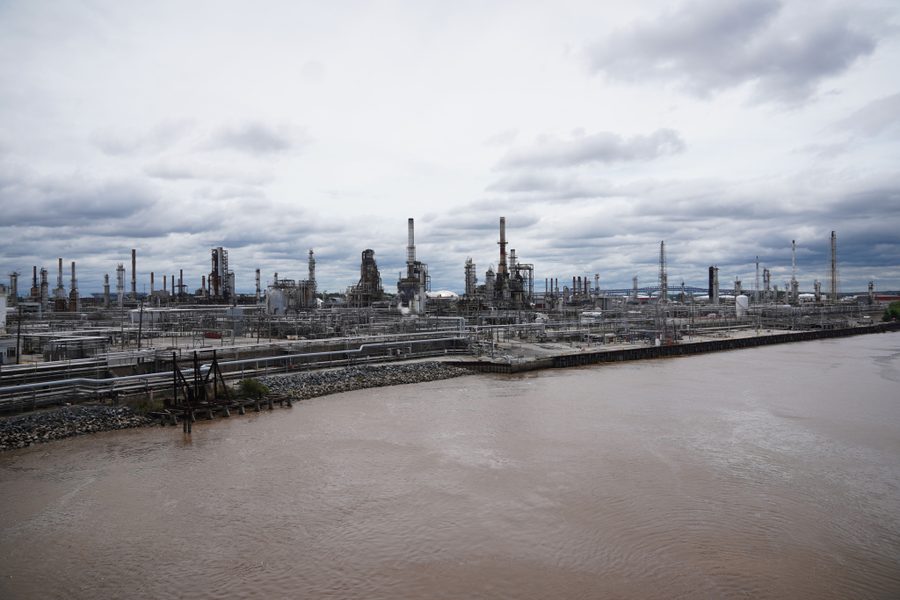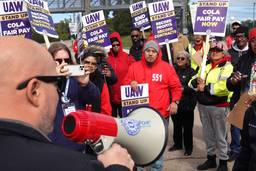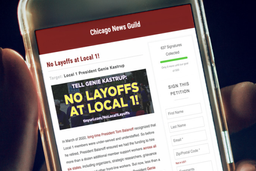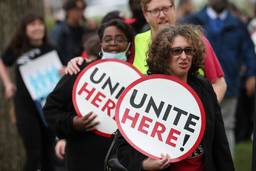Climate Activists Can’t Afford to Ignore Labor. A Shuttered Refinery in Philly Shows Why.
Mindy Isser

In the early morning hours of June 21, 2019, a catastrophic explosion tore through the Philadelphia Energy Solutions (PES) oil refinery in the southwest section of Philadelphia. The training and quick thinking of refinery workers, members of United Steelworkers Local 10-1, averted certain disaster and saved millions of lives. One month later, on July 21, PES declared bankruptcy — their second in as many years — and began to close down the refinery in the following months, laying off almost 2,000 people with no meaningful severance. According to workers who spoke with In These Times, the refinery stopped running crude oil in early August, although there are fewer than 100 workers who were kept on as caretakers for the waste water and steam generating units.
The fire on June 21 and the mass layoffs that followed impacted more than just the physical site of the refinery and the workers who made it run. It also ignited a debate throughout the city about what would become of the refinery site, which has been in operation for more than 150 years. On the one hand, the explosion underscored the dangers the refinery posed to the community immediately surrounding it, and the city as a whole. On the other, the subsequent closure of the refinery meant that workers were suddenly out of work, with no plan from PES or city officials of how to put them back to work.
This debate, while focused on Philadelphia, reflects much larger questions roiling supporters of a Green New Deal: how to ensure a just transition for fossil fuel workers who lose their jobs, and how to build bonds between unions looking out for their members, and climate organizers trying to stop fossil fuel extraction. Interviews with community organizers trying to curb the refinery’s toxic pollution, and workers laid off from the refinery, indicate that the answers are not easy, but require listening to workers, many of whom are already thinking about climate change — and forced, right now, to deal with the hardships of losing their jobs. In the words of Jim, a former worker who requested only his first name be used due to fear of retaliation, “Fossil fuels need to be phased out aggressively. That being said, I’m in the industry. You can’t just allow the people in that industry to become like the coal miners, just floundering.”
A toxic polluter
Such questions have been the focus of ongoing organizing by community members who have long been concerned about the health impacts the refinery has on the soil, water and air. The refinery is in the 19145 zip code, which has one of the highest rates of hospitalization for asthma in the city, along with one of the highest cancer mortality rates, in a city that has the “highest cancer rate of any large city in the United States,” according to the National Cancer Institute.
The connection between illnesses and the refinery is not lost on community members, nor on Philly Thrive, an organization founded in 2015 to “win a just transition of the Philadelphia Energy Solutions oil refinery, the largest and oldest oil refinery on the East Coast.” The organization knocked on doors around the refinery and embarked on a “listening project” in order to better understand the experiences of neighbors, most of whom are Black and low-income. Alexa Ross, co-founder of Philly Thrive, says that the organization exists outside of the “non-profit, white, middle class” environmental movement, and is currently focused solely on its “Right to Breathe” campaign, which is organizing around health and safety over profit, no fossil fuel expansion, and a green economy for all.
After hearing countless horror stories from neighbors about asthma, bronchitis, cancer and early deaths, Philly Thrive was unable to ignore the urgency of the crisis. Ross told In These Times that “you can compare the refinery to the next 100 sources of pollution all together, and the refinery is still the majority of toxic emissions.” The refinery was the number one source of air pollution in Philadelphia, responsible for 9% of the city’s fine particle emissions and 20% of greenhouse gas emissions, according to the Department of Public Health. It was also the single largest emitter of toxic pollutants, including known carcinogens, representing nearly 57% of such emissions in 2016.
A lack of trust
And although Philly Thrive also lists a commitment to a “just transition to clean energy and living wage green jobs” on its website, it also publicly acknowledges that “it has been very difficult to carve out substantial time in our organizing” to build relationships with workers at the refinery. Ross says Thrive was “told by our connections to USW that they wanted nothing to do with us if we were anti-fossil fuel. We’re one of the only environmental groups that hasn’t been invited to the table with labor, because we don’t think we can afford to say anything besides that we need to transition from fossil fuels now. So we’ve been denied access to the labor movement and USW in particular.”
This lack of trust between community members and refinery workers has been painful for both groups, and the challenges they’ve encountered connecting these two distinct, but ultimately connected, struggles have been difficult to transcend. Philly Thrive says that at public meetings about the future of the refinery, “fear, anger and grief have found likely targets in each other instead of the companies and executives responsible for the refinery.”
One former refinery worker even took to Twitter shortly after the explosion to slam Philly Thrive. Jim Savage, former President of USW Local 10-1, the union that represented workers at the refinery, wrote that “hypocritical opportunists ran to microphones, with fires still burning out of control, calling for the immediate shutdown of the refinery with an ‘oh, by the way, take care of the workers by doing x, y, and z.’ Workers that they didn’t bother to speak with first. A week later, they’re still doing it and still no conversation with the workers. Obviously, they prefer the flowery words of solidarity without any actual effort to create solidarity.”
Jim, the refinery worker mentioned earlier, says that workers saw Philly Thrive “as advocating for a total shutdown, no industrial use, which to people who work there is very scary. We talked about some transition with some relief for the workers and this wouldn’t fit that bill.” When pressed about what a transition with relief for workers would look like, he said that “it would include medical [insurance] while we are laid off with schooling or training included… A severance would have helped. This is just me though. A lot of workers wouldn’t agree but I think a substantial amount would. Some won’t be happy with anything less than their refinery jobs back.”
And it’s not hard to understand why. The PES refinery provided around 1,100 full-time jobs and as many as 850 contracted positions to workers largely in the Philadelphia area. Most of the workers I spoke with only had high school degrees, and ended up making at least $100,000 per year, often closer to $150,000 or $200,000 with overtime and bonuses, thanks to their strong union and the dangerous nature of their work.
B.N., who requested only his initials be used due to fear of retaliation, worked at the refinery since 2006 and is now a facilities manager at a university, making about half the money he previously made. He says “it’s much safer, but I do miss the money, and it’s very hard to go backwards.” He says that for his old coworkers, the job search is “brutal,” with people getting offered jobs that pay $17 an hour. Some haven’t found anything at all and are still relying on unemployment. Others have moved to Texas, Arkansas, or Louisiana, chasing refinery jobs on the Gulf Coast, leaving their families behind.
When faced with the option of either keeping well-paying jobs or putting what may feel like blind faith into hypothetical plans for a transition of the site in the spirit of the Green New Deal, it’s not hard to understand why refinery workers have fought to keep the refinery open — especially when they are not included in the discussions around what a transition could or should look like. The challenges facing community members and workers in Philadelphia over the future of the former PES refinery site are not unique, but rather, indicative of a wider gap that must be bridged in order to eventually win a Green New Deal.
The labor movement and climate movement have often been painted as unlikely allies, locked in a natural and consistent conflict. Although some unions have begun to embrace the need to move away from fossil fuels and seriously confront climate change, many unions have dug their heels in and reaffirmed their commitment to extractive industries, such as Laborers’ International Union of North America, International Brotherhood of Electrical Workers and United Mine Workers of America. The AFL-CIO infamously came out in support of building oil pipelines in the face of massive protests by Indigenous communities in the Dakotas.
While there’s a lot of talk of a “just transition” away from fossil fuels — both in Philadelphia around the refinery, and beyond — we don’t have any examples in this country to model this transition after yet. It makes sense that a union whose members work in the fossil fuel industry would see its interests as tied to the fate of that industry, especially given the tendency of many unions to see their role as fighting solely for the interests of their members, divorced from the interests of the working class as a whole.
A common enemy
It’s clear that a basis for a higher level of solidarity must be found to overcome this division. One potential way to do this is to identify a common enemy, one who is responsible for both exploiting and endangering the safety of the workers in these often dangerous industries, and for the devastation these industries have on the surrounding communities. This common enemy is, of course, the boss, who is often aided by tax breaks and political support from local and state governments.
The Commonwealth of Pennsylvania provided PES with $25 million for refinery equipment upgrades and rail car infrastructure in 2012, along with numerous other tax incentives and write-offs. PES was also granted protection by the state for liability related to historical environmental contamination at the site, or contamination resulting from Sunoco’s (the previous owner) operations. Following the June 21 explosion and subsequent bankruptcy filing, PES executives were paid $4.59 million in retention bonuses. In a November 22nd filing with the U.S. Bankruptcy Court, PES requested to create an additional bonus pool to payout executives, ranging from $2.5 million to $20 million if the sale of the refinery generates $1 billion in net proceeds. Philadelphia Energy Industries, created by former PES chief executive Phil Rinaldi and S.G. Preston, a biofuels company, have put in a bid to purchase the refinery in order to reopen it. Rinaldi left PES in 2017, but other executives with whom he had worked closely for years were the ones who closed the refinery, filed for bankruptcy, and received massive payouts for themselves. And in the aftermath of the devastation caused to the lives of refinery workers and the surrounding community, Rinaldi has cynically emerged as a key figure calling to restart operations at the shuttered refinery site.
Even though USW Local 10-1 President Ryan O’Callaghan has publicly bashed the executives for their lavish payouts, he also said, “The idea of retraining us for jobs that don’t exist is not the answer. The idea to put a solar panel farm on the site is not the answer. The answer is to restart the refinery now.” So even though union members were sold out by the owners of PES — who took giant payouts while leaving them with nothing — the union is indirectly allying with them to work to re-open the refinery.
But is it really about the refinery, or is it about good jobs? B.N. said that “If it was a solar or a wind farm, and they were paying what the refinery paid, [the workers] would be there in a second. It’s about the money. They’re not defending the industry — they’re defending their job and their paycheck. If they could make the same money working for Greenpeace, they would do it.” When the only option is to either defend the fossil fuel industry or have a poorly paying, insecure job, the vast majority of workers are going to defend the industry — no matter their personal beliefs about climate change.
On January 17, the site will be put to auction, with multiple companies lining up to re-open the refinery. Residents and community groups like Philly Thrive don’t have a seat at the table in discussions about the refinery’s future, but USW does because it is a creditor in the refinery’s bankruptcy case. What would it be like if the union chose to partner with Philly Thrive instead of with the 1%, and signed on to their demands of health and safety over profit, no fossil fuel expansion, and a green economy for all? The union could stand with community members and commit to shutting down the refinery, for both the safety of the workers, the surrounding community, and our hope for any kind of fossil fuel-free future — but only if there is a plan for severance pay and health insurance for workers, along with training and job placements at either the old refinery site or elsewhere.
The people most affected by climate change will be in the working class, whether they’re members of USW Local 10-1, members of another union, or not union members at all. The Phil Rinaldis of the world, by contrast, will be much more insulated from climate catastrophe. This is a pressing challenge to both the labor and climate movement, given the particular urgency for drastic action to address the impacts of climate change before it’s too late. How can the labor movement move towards acting in the interests of their members, yes, but increasingly in the interests of workers as a whole? And how can the climate movement engage labor to help make the Green New Deal a more concrete program that workers can believe in? In order to fully confront the complexities of how to actually have a just transition away from fossil fuels, workers in those industries need to be at the front of those conversations.
As B.N. puts it, “We’ve done a lot of great things in this country. We can transition. Look at World War II, GM stopped making cars for commercial production — they started devoting all of their efforts to the war. We can do big things in this country.”

I hope you found this article important. Before you leave, I want to ask you to consider supporting our work with a donation. In These Times needs readers like you to help sustain our mission. We don’t depend on—or want—corporate advertising or deep-pocketed billionaires to fund our journalism. We’re supported by you, the reader, so we can focus on covering the issues that matter most to the progressive movement without fear or compromise.
Our work isn’t hidden behind a paywall because of people like you who support our journalism. We want to keep it that way. If you value the work we do and the movements we cover, please consider donating to In These Times.







